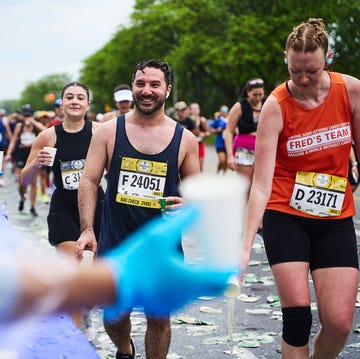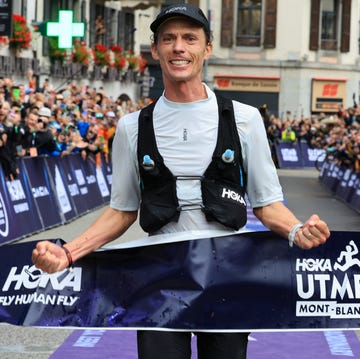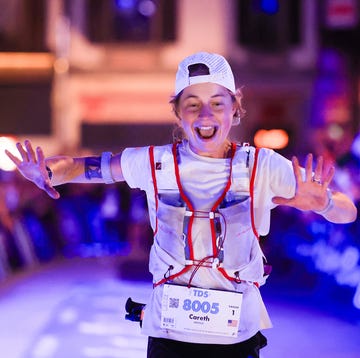At indoor track meets, it’s common to see athletes coughing during post-race interviews or gulping water to ward off cotton mouth. Known as “track hack,” the cough comes with the territory for those running inside during the coldest (and driest) months of the year.
Jonathan Schindel knows this well. As the co-president and chief financial officer of The Armory Foundation, the nonprofit which puts on the Millrose Games, he’s heard complaints about The Armory’s dry air for years.
At 114 years old, the former military barracks in Manhattan’s Washington Heights has plenty of New York City quirks. In the early 1990s, the building was retrofitted to include an indoor track, which has now become one of the busiest tracks in the world. Each year, 300,000 people visit The Armory and athletes—from youth to masters levels—log an estimated one million miles on the track.
During the COVID-19 pandemic—when the facility kept many of its windows open to improve air circulation—Schindel decided to beat the “Armory hack” once and for all. The staff ran air tests and found that the humidity in the building ranged from 10 to 15 percent. After some research, they determined that an ideal range would be more than double that: 30 to 40 percent.
To hit the target, the Armory worked with the industrial humidification company Condair to customize a system for the building. They installed spigots to the air vents in the rafters, which puff out water droplets when the humidity levels drop below the 35 percent threshold. Schindel likens it to the misters you’d find in the grocery store produce aisle.
Some Armory employees have dubbed the structure “the dragon,” because it spits out water like a dragon spits out fire and it “slays the track hack.”
The project was finished in November 2023, and it was fully operational in time for the 2024 Millrose Games. But many of the professional athletes didn’t notice it until this year.
Grant Fisher, who set a world record of 7:22.91 in the indoor 3,000 meters at the meet, noticed the system for the first time the day before the meet, when he was using the facility for his pre-race routine. After setting the record, he said his mouth was still fairly dry, but he appreciated the technology.
“If that means I got 0.1 seconds faster over 3K, I think it’s worth it,” he said.
His coach, Mike Scannell, thought it was advantageous, too. “I absolutely like the misters because indoor, and in the winter, it’s very, very dry,” he said. “Your throat gets parched and you can’t run as fast.”
Like Fisher, Josette Andrews and her coach, Kelsey Quinn, hadn’t clocked the humidifiers until the day before Millrose. And they’ve never noticed a similar system at other indoor facilities.
“I liked it, it felt good,” Andrews, who finished second in the 3,000 meters, said. “Every lap, I got a mist to my face.
“My mouth is still dry, but we’ll see if I have a cough,” she continued. “I don’t have that bloody taste.”
With increased humidity comes decreased air resistance, too, although it may seem counterintuitive. Humid air holds more water molecules, which displace heavier gases, such as nitrogen and oxygen, according to Popular Science. The lower air density can play into the favor of athletes—for example, sprinters who are running all-out for only six or seven seconds may experience less drag.
Modernizing the building doesn’t help only athletes; fans benefit as well. Schindel noted that more humid air can help combat the spread of flus or colds.
The humidity system runs year-round, all day, to maintain equilibrium. The Armory hosts other events throughout the year, like college graduations and the New York state bar exam.
Some guests have told Schindel they feel like the air has become cleaner.
“With the higher humidity, it’s not necessarily that the air is cleaner, [but] it’s creating a more comfortable environment for everybody in the building,” he said.
On Saturday, though, quick times were the main concern for the athletes. And they certainly delivered them.
Plenty of records were set, in addition to Fisher’s mark. Yared Nuguse ran the men’s mile world record (3:46.63). Sadie Engelhardt and Cooper Lutkenhaus broke high school records in the mile and 800 meters, respectively. And Josh Hoey nabbed the American record in the 800.
Theo Kahler is the news editor at Runner’s World. He’s a former all-conference collegiate runner at Winthrop University, and he received his master’s degree in liberal arts studies from Wake Forest University, where he was a member of one of the top distance-running teams in the NCAA. Kahler has reported on the ground at major events such as the Paris Olympics, U.S. Olympic Trials, New York City Marathon, and Boston Marathon. He’s run 14:20 in the 5K, 1:05:36 in the half marathon, and enjoys spotting tracks from the sky on airplanes. (Look for colorful ovals around football fields.)














